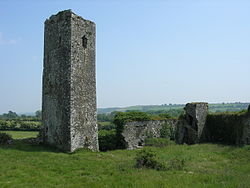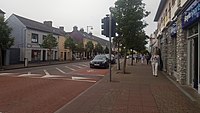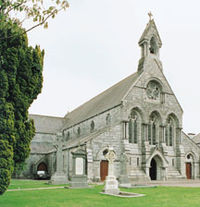Ballincollig
| Ballincollig Irish: Baile an Chollaigh | |
| County Cork | |
|---|---|
 Ballincollig Castle | |
| Location | |
| Grid reference: | W595708 |
| Location: | 51°53’17"N, 8°35’21"W |
| Data | |
| Population: | 18,621 (2016) |
| Postcode: | P31 |
| Dialling code: | 021 |
| Local Government | |
| Council: | Cork City |
| Dáil constituency: |
Cork North-West |
| Website: | www.ballincollig.ie |
Ballincollig is a suburban town at the west side of the City of Cork in County Cork, beside the River Lee on the R608 road. The 2016 census recorded a population of 18,621.
The town stands beyond the Cork green belt.
History

Originally known as Maghmakeer as early as the 14th century, the town eventually came to be known after the Coll (or Cole) family who built Ballincollig Castle during the reign of King Edward III, before selling it to the Barrett family in either 1468 or 1469.[1]
The castle was taken from Andrew Barrett by Confederate rebels in 1641, but they were expelled by English Parliamentary forces under Murrough O'Brien, Earl Inchiquinn, in 1645. It was garrisoned for James II in 1689, during the Williamite war in Ireland, then remained unoccupied after his defeat, and fell into decay.
The Ballincollig Royal Gunpowder Mills were opened in 1794 by Charles Henry Leslie, a prominent Cork businessman. Eleven years later, the mills were bought by the government, who were preparing for war with Napoleon, and the barracks were built to protect the supply of gunpowder. It was one of the largest gunpowder mills in the British Isles. In 1837, the mill employed several hundred workers, and by 1880, Ballincollig was one of the largest industrial establishments in Cork, with the mill employing many men and boys from the area.
The Cork to Macroom rail line served Station House (at the south end of Station Road). Ballincollig railway station was opened on 12 May 1866, closed to passenger traffic on 1 July 1935, closed to goods traffic on 10 March 1947 and finally closed altogether on 1 December 1953.[2]
With the closure of the Gunpowder Mills in the early 1900s, Ballincollig became little more than a small village on the road from Cork city to the larger market town of Macroom. The 3rd Royal Munster Fusiliers (Reserve) Battalion were stationed there during the Great War. Other Regiments stationed in the Barracks before it was decommissioned were 1st Field Artillery Regiment and 8th Field Artillery Regiment. The recently decommissioned Murphy Barracks was a major source of employment. In the 1970s, Ballincollig developed as much more of a satellite town, with many housing developments constructed around the old village, and housing people who worked in Cork city or its suburbs. This expansion continued through the late 80s and 90s. Consequently, the town's population has risen dramatically, particularly with the westward expansion of the town and Ballincollig grew to be largest town in the county.
Churches

- Roman Catholic:
- Church of Christ Our Light, a modern church designed by a local architectural firm, on the west side of the town
- Church of St Mary and St John, near the centre of the town, on Station Road
- Baptist: Bible Baptist Church, which meets in the Westgate Foundation on the west end of town. The church is associated with the Cork Bible Institute and other Gospel ministries.
About the village
The Ballincollig Royal Gunpowder Mills along with its visitor centre/museum is on the north side of the town. Some buildings in the Gunpowder Mills are now in disrepair but the area is still open to walkers in the Regional Park.
The Coolroe Lime Kiln is an example of the historic quarrying in the Coolroe area of the town.
Ballincollig Regional Park extends over 135 acres and in it stands the gunpowder mill|. Also in the site is a system of canals used during the manufacturing process connecting all the process areas in a single flat system without locks, fed from the River Lee at the western end of the site. The park contains soccer pitches, a rugby pitch, walkways, a skateboard facility, and free-to-use outdoor fitness equipment.
There is also another playground on the western side of the town.
Sport
- Gaelic sports: Ballincollig GAA
- Rugby: Ballincollig RFC
Outside links
| ("Wikimedia Commons" has material about Ballincollig) |
References
- ↑ MacCotter, Paul (2015). "Ballincollig's Mediæval Origins". Times Past 2014 - 2015, Journal of Muskerry Local History Society 11: 3. https://muskerryhistory.files.wordpress.com/2015/08/times-past-2014-15final.pdf.
- ↑ "Ballincollig station". Railscot - Irish Railways. http://www.railscot.co.uk/Ireland/Irish_railways.pdf.
